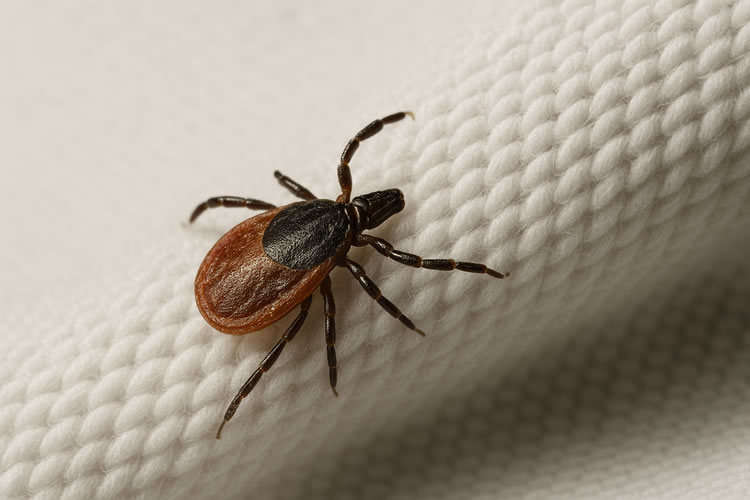It’s hunting season, the hills are blazing with color, and Vermont’s woods are full of people doing what they do best — walking, scouting, cutting, raking, and leaf-peeping. It’s the best time of year to be outside. But it’s also prime time for the most obnoxious tag-along in the Northeast: the deer tick. They don’t care if you’re hiking Camel’s Hump, dragging a deer out of the brush, or splitting wood behind the barn. If you’re warm and moving, you’re fair game.
Vermont’s blacklegged tick — the deer tick — is the most stubborn parasite in the North Country. Snow? It hides under leaf litter and waits. Freezing nights? No problem. Drought? It hunkers down until humidity returns. You can’t starve it, freeze it, or reason with it. The only thing that consistently kills it is a chemical named permethrin, and the U.S. military figured that out decades ago.
The Hard Science
Ticks aren’t insects; they’re arachnids, like tiny armored spiders with a needle. They only feed three times in their life — larva, nymph, adult — but each meal fuels the next stage and keeps the diseases cycling through. Lyme, anaplasmosis, babesiosis, Powassan virus — all of them hitch rides inside this one tiny bloodsucker.
And they don’t “die off” in winter like people think. They go semi-dormant, crawling under snow-covered brush or moss, and pop back out as soon as temperatures rise above freezing. Some even stay active on mild days in January. That’s why you can pull one off in the middle of winter and still have a pulse on it.
Forget the Politics — It’s Biology
You don’t need a lecture on global warming to explain why ticks thrive here. Vermont is perfect for them because we’ve got hosts (mice, deer, dogs, people) and plenty of cover. They can survive cold snaps because they evolved in them. The only weather that truly beats them is dry heat — the kind that turns forest floor dust-brown and drops humidity under 40%.
So yeah, a hot dry summer will knock them back. But one wet spring and they’re right back at it.
🍁 Make a One-Time Contribution — Stand Up for Accountability in Vermont 🍁
Permethrin: The Real Deal
DEET makes ticks uncomfortable. According to the CDC, permethrin-treated clothing reduces their ability to bite or stay attached. When the fabric or gear is coated with permethrin (typically 0.5 %), contact with the chemical disrupts ticks’ nervous systems. One randomized controlled trial among outdoor workers found ≈65% fewer tick bites in year one, and about 50% fewer in year two with long-lasting permethrin-impregnated clothing.
Pre-treated clothing or DIY-application both work. If you spray your own: use around 0.5% permethrin solution, apply outdoors, let gear dry fully overnight before use, and expect effectiveness to decline with heavy washing or wear.
For someone working farms, hiking or hunting in Vermont’s woods, permethrin-treated boots, socks and pants are one of the best protective layers available — but not foolproof. They must be part of a layered plan: skin repellent, clothing treatment, good tick checks, and avoiding dense brush when possible.
The Dog Question
If your dog likes licking boots, don’t let it near them while the spray’s wet. Once dry, the permethrin is bonded into the material and isn’t a risk — even if your mutt keeps mouthing your laces. Cats, though, are a different story; don’t spray around them or let them near it wet.
What Actually Works
- Treat your work clothes and boots with permethrin.
- Use DEET or picaridin on skin — that’s your second shield.
- Check every night, especially behind the knees, waistband, and hairline.
- Keep the grass short and brush cleared around work areas.
- If you see one crawling, flick it into alcohol — don’t crush it barehanded.
What To Do If You Find One Attached
- Don’t panic — and don’t crush it. The goal is to remove the whole thing, not to explode it.
- Use fine-tipped tweezers or a tick twister.
- With tweezers: grab the tick as close to the skin as you can and pull straight out, slow and steady.
- With a tick twister — a little metal or plastic tool with a V-shaped notch — slide it flat against the skin until the tick fits into the slot, then rotate gently while lifting. It’ll back out cleanly, jaws and all.
- Clean the bite site with rubbing alcohol or soap and water.
- Don’t freak out if the jaws stay in. It happens all the time. They’ll work their way out on their own like a splinter.
- Watch for symptoms over the next few weeks — rash, fever, fatigue, or joint pain. If something feels off, see a doctor and mention the bite.
That’s it. No burning, no Vaseline, no folklore tricks. Just remove it cleanly and move on.
The Bottom Line
Ticks aren’t multiplying because of politics or melting ice caps. They’re multiplying because they can. They’re evolution’s little middle finger to comfort and assumption — built to survive, built to feed, and built to drive biologists crazy.
You can’t reason with a tick, but you can kill it. And for once, that’s not a metaphor — it’s chemistry.
Dave Soulia | FYIVT
You can find FYIVT on YouTube | X(Twitter) | Facebook | Instagram
#fyivt #VermontOutdoors #DeerTicks #Permethrin
Support Us for as Little as $5 – Get In The Fight!!
Make a Big Impact with $25/month—Become a Premium Supporter!
Join the Top Tier of Supporters with $50/month—Become a SUPER Supporter!









Leave a Reply